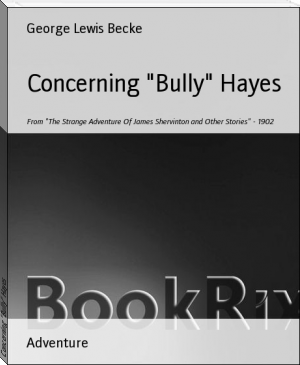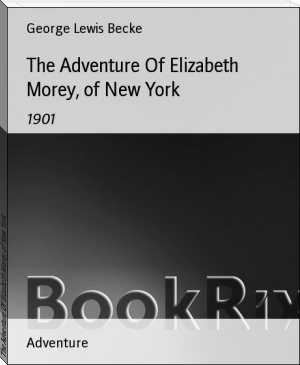Ridan The Devil And Other Stories, George Lewis Becke [best sci fi novels of all time txt] 📗

- Author: George Lewis Becke
Book online «Ridan The Devil And Other Stories, George Lewis Becke [best sci fi novels of all time txt] 📗». Author George Lewis Becke
Given a good breeze and plenty of daylight, the whale-ships of the olden days could stand round the western horn of the island, a projecting point rendered pleasingly conspicuous by the grove of graceful coco-palms which Cook was so glad to observe so many years before, and then enter a deep bay on the north-west coast, where they obtained good anchorage in from fifteen to twenty fathoms of water of the most wonderful transparency, and within a mile of the vast stretches of white sandy beach that trend away for miles on either hand. And then the sailors, overjoyed at the delightful prospect of running about in the few and widely-apart palm groves, and inhaling the sweet, earthy smell of the thin but fertile soil, covered with its soft, thick bed of fallen leaves, would lower away the boats, and pulling with their united strength through the sweeping eddies of the dangerous passage, effect a landing on a beach of dazzling whites and situated in the inner south-west border of the wide lagoon.
On our first visit to the island, in 1872, we had some glorious fishing; and when we returned on board, under the rays of a moon that shone with strange, uncanny brilliancy, and revealed the coral bottom ten fathoms below, the scene presented from our decks was one of the greatest imaginable beauty, though the loneliness of the place and the absence of human life was somewhat depressing. We remained at the island for three days, and during our stay our crew of South Sea Islanders literally filled our decks with fish, turtle and birds' eggs. Curiously enough, in our scant library on board the little trading vessel I came across portion of a narrative of a voyage in a South Seaman, written by her surgeon, a Mr Bennett, in 1838,{*} and our captain and myself were much interested in the accurate description he gave of Christmas Island and its huge rookeries of oceanic birds.
* _Narrative of a Whaling Voyage round the Globe, from_ 1833
to 1836. By F. D. Bennett.
This is what he says: 'Here and there among the low thicket scrubs are vast rookeries of aquatic birds, whose clamour is deafening. They nest and incubate upon the ground, and show not the slightest fear of the approach of human visitors. Among the sooty terns, whose number it was impossible to estimate, were many hundreds of tropic birds and pure snow-white petrels.' (He no doubt imagined the pure snow-white petrels to be a distinct species--they were young tropic birds.) 'These latter, who flew with a gentle, flapping motion, would actually fly up to us and scan our countenances with an almost human expression of interest and curiosity.' (Darwin, in his account of another Christmas Island in the Indian Ocean, also describes these gentle creatures as being of ethereal beauty.) 'Some, indeed, permitted themselves to be caught, and although their delicate, fragile forms quivered with fear when they came in contact with our hands, they would, when released, return to us again and again, as if seeking to solve the mystery of what strange beings were these that had invaded their retreat. In one rookery there were many varieties of these oceanic birds, and a species of booby that seems to be peculiar to Christmas Island. In size and colour they much resemble the ordinary gannet of our cold northern seas. Their plumage is of a wondrously bright snow white, with the exception of the primary and secondary feathers of the wings, and the _retrices_ or tail feathers, which are of a glossy black. The skin of the cheeks and chin is devoid of feathers, and of a jet black colour, the beak a delicate yellow blue, the legs bright blue. The solicitude of the female birds of this species for their offspring was most interesting to witness. Their nests were of the rudest description, being merely circular heaps of sand raised in the open plain and exposed to the fury of storms. As we approached the nests the mother birds settled themselves down upon their single egg and screamed loudly, but would permit themselves to be lifted off, yet struggled violently in our hands to get back again. Although there were thousands of these nests within a radius of an acre, a brooding hen might easily have been passed unnoticed, for her white plumage corresponded so well with the hue of the coral sands that one was apt to kick against the nest were it not for the agonised, barking note of the poor mother. The male birds, however, of this species did not show any marital concern for their partners. They were usually seated near the nests, but at once took to flight upon our approach. Further on, among a thicket of scrubby vegetation, we found a rookery of many thousands of the superb red-tailed tropic bird (_Phaeton phoenicurus_), also engaged in incubation. Their nests were mere circular excavations in the sand, under the shade of the bushes of the thicket. Each nest contained an egg of pure white, dotted with delicate lilac spots, and in size rather larger and rounder than that of the domestic hen. The females, as well as the males, made no attempt to escape from their nests on our approach, whether they had or had not the care of eggs, and consequently several of our crew, with innate Polynesian vanity, soon caught a number, and plucking out the two long scarlet tail feathers placed them in their hat bands.
'A hundred yards away from the rookery of the tropic birds was one of a colony of the snowy tern before mentioned. These gentle, black-eyed creatures do not even pretend to construct a nest, but simply deposit a solitary egg upon the bough of a tree (like the _gogo_, or whale bird). They select for this purpose a tree destitute of foliage, and a branch of horizontal growth. It is strange that, notwithstanding the exposed situation of these eggs, they are very difficult to find; and it was not until long after the solicitude of the parent birds informed us that their spot of incubation was near that we could solve the mystery which attended their nursery. Each egg is the size of a pigeon's, and marked with either blood or chocolate-coloured splashes and spots of irregular shape. Considering the slenderness of the branches on which they are deposited, it is remarkable that the eggs (which appear to be at the mercy of every passing breeze) should yet retain their extraordinary position during incubation.' (Any Pacific Islander could easily have explained this seeming mystery. The shell, when the egg is laid, is covered with a strong adhesive coating. I have often seen a single egg, laid upon a slender branch, swaying about in a strong trade wind, and yet remain firmly in its position.) 'What may be the habits of the newly-hatched birds we had no opportunity of learning, as none of the latter came within our observation.
'Small reef birds (tern) were present in prodigious numbers, skimming the waters of the coast with an erratic, rapid, but yet graceful flight, like that of the stormy petrel. At night they assembled in vast numbers on an islet in the lagoon, to roost on the trees. They are about the size of an Australian snipe, and their forms are models of elegance and beauty. Their plumage is in true slate colour, the secondary wings are white, and a narrow white zone surrounds each eye; their legs and feet are a pale blue, with white webs.
'Every now and then as we, during our visit, walked along the snow-white beaches, great crowds of golden-winged plover and tiny snipe sprang skyward, and swept in graceful gyrations over the broad expanse of water, till they settled upon some sandy spit or spot of projecting reef; and, indeed, the immense concourse or frigate birds, boobies, terns, petrels and other aquatic denizens of the island filled us with boundless astonishment.
'At night time there crept out from their lairs in the loose coral shingle that lined the scrub at high-water mark, incredible numbers of huge "land lobsters"--the "robber crab" of the Pacific Islands. They all crawled to within a few feet of the placid waters of the lagoon, where they remained motionless, as if awaiting some event--possibly to prey upon the smaller species of _crustaceae_ and turtle eggs.'
Christmas Island, in its structure and elevation, much resembles Palmerston Island, Arrecifos or Providence Island (the secret rendezvous of Captain 'Bully' Hayes), Brown's Range, and other low-lying atolls of the North and South Pacific. The greater part of the interior of the island is, however, despite the vast number of coco-nuts planted upon it during the past ten years, still sadly deficient in cheerful vegetation.
The waters of the lagoon vary greatly in depth, but generally are shallow and much broken up by sandy spits, reefs and huge coral boulders which protrude at low water, and the surface is much subject to the action of the trade wind, which, when blowing strong, lashes them into a wild surf; and the low shores of the encircling islets, that form a continuous reef-connected chain, are rendered invisible from the opposite side by the smoky haze and spume which ascends in clouds from the breaking surf that rolls and thunders on the outer barrier reefs.
In the interior no fresh water is obtainable, although in the rainy season some of a brackish quality can be had by sinking shallow wells. This water rises and falls in the wells in unison with the tides. Here and there are very extensive swamps of sea-water, evaporrated to a strong brine; the margins of these are clothed with a fair growth of the pandanus or screw-pine palm, the fruit of which, when ripe, forms a nutritious and palatable food for the natives of the Equatorial Pacific Islands.
The island where Captain Cook set up his observatory is but a small strip of sandy soil, clothed with a few coco-palms, some screw-palms (pandanus), and a thick-matted carpet of a vine called _At At_ by the natives. The only quadrupeds are rats, and some huge land tortoises, similar to those of the Galapagos Islands. They are most hideous-looking creatures, and, being of nocturnal habits, like the great robber crab, are apt to produce a most terrifying impression upon the beholder, if met with in the loneliness of the night. The present human occupants of Christmas Island are, however, well supplied with pigs and poultry; and though this far-away dot of Britain's empire beyond the seas is scarcely known to the world, and visited but twice a year by a trading vessel from Sydney, they are happy and contented in their home in this lonely isle of the mid-Pacific.
BILGER, OF SYDNEY
A death in the family brought about my fatal acquaintance with Bilger. A few days after the funeral, as my sister and I sat talking on the verandah of our cottage (which overlooked the waters of Sydney Harbour) and listened to the pouring rain upon the shingled roof, we saw a man open the garden gate and come slowly up to the house. He carried an ancient umbrella, the tack lashings of which on one side had given way entirely, showing six bare ribs. As he walked up the path, his large, sodden boots made a nasty, squelching sound, and my sister, who has a large heart, at once said, 'Poor





Comments (0)